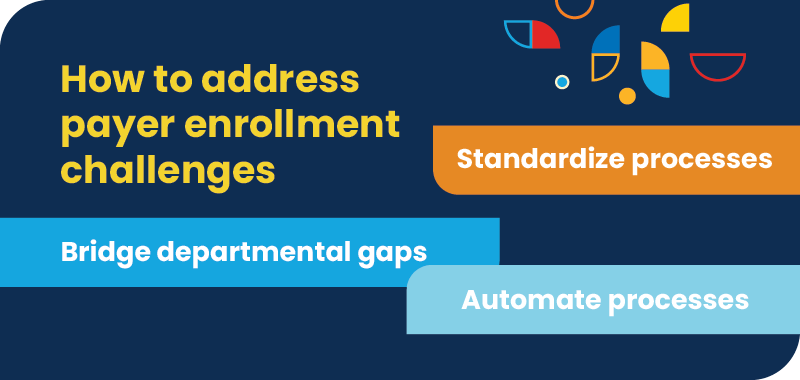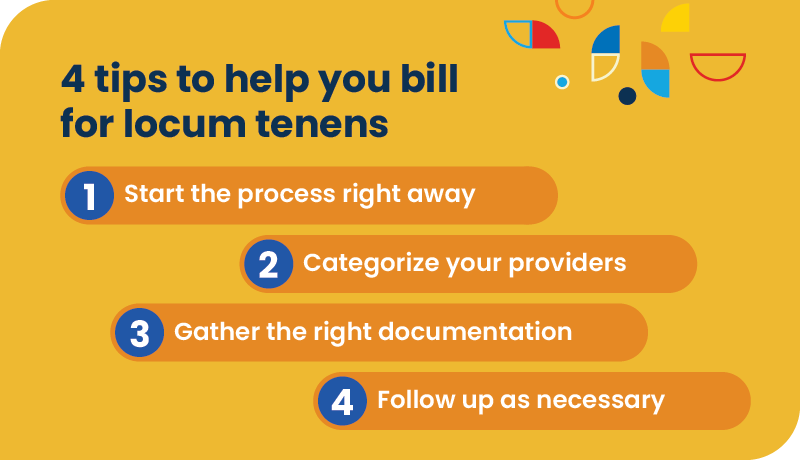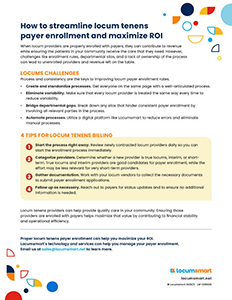When locum providers are properly enrolled with payers, they can contribute to revenue while ensuring the patients in your community receive the care that they need. Payer enrollment is tricky, however, as payer rules are complex and can vary widely.
Despite the challenges, the revenue opportunities make payer enrollment worth the effort. Here, we’ll look at some of the common challenges of locum tenens billing, discuss ways to overcome those challenges, and provide tips for proper locums billing.
Payer enrollment challenges
In many situations, locum providers can be enrolled with payers like insurance companies and Medicare or Medicaid. This enrollment allows the healthcare organization to bill payers for services that the locum physician provides. Payer enrollment is crucial for transforming locums from a cost center to a revenue generator.
Despite the benefits of payer enrollment, the intricacy and variety of payer rules make it difficult for healthcare organizations to consistently enroll their locum providers with payers. Additionally, departmental silos within hospitals can lead to process failures.
“There are many other things that need to happen above and beyond putting the locum doctor to work, and those things get forgotten. So even within enrollment and revenue cycle management, there are silos and walls,” says Thomas Lanvers, division president of Locumsmart.
It may not be clear within the organization whose role it is to provide locums payer enrollment services. Does it belong to recruiting or credentialing? Or does it sit with billing? “Whenever you don't have true ownership, it's very difficult to drive good results,” Lanvers says.

Is it worth the effort? How Ardent Health increased revenue by $2.5 million in one year
How to address the challenges of payer enrollment
“Process and consistency are the keys to improving locum payer enrollment rates and avoiding wild variation in the decisions that are made,” Lanvers says. “An absence of rules creates a lot of ambiguity.”

Standardize processes. “In order to get results and bill appropriately, you have to have a process,” says Bob Shumard, director of client services at Locumsmart. Within that process, it’s important to ensure that every locum provider is treated exactly the same way every time to reduce variability.
Bridge departmental gaps. Break down any silos that are getting in the way of consistent payer enrollment by involving all relevant parties in the process.
Automate processes. “Successful payer enrollment is nearly impossible if you're working from email and manila folders,” Shumard says. “Going digital allows you to improve your performance.” Digital platforms like Locumsmart reduce errors and missed opportunities by eliminating manual processes and physical management systems.
4 tips to help you bill for locum tenens
These time-tested tactics can help your organization gain the benefit of locum payments.

1. Start the process right away
Review newly contracted locum tenens providers daily so you can start the enrollment process on day zero and ensure no providers fall through the cracks.
2. Categorize providers
Determine whether a new provider is a true locum, interim, or short-term clinician. According to the Centers for Medicare and Medicaid Services, a true locum covers for a provider who’s on approved PTO for no more than 60 days. Healthcare organizations can bill for true locum providers under the NPI of the provider who’s on PTO.
Interim locum providers give healthcare organizations supplemental coverage—for example, when a team is short-staffed—and they may have longer or repeat assignments. Enrolling these providers with payers is generally a good idea.
When it comes to very short-term locum providers whom you don’t anticipate using again, payer enrollment is less relevant.
3. Gather documentation
Work with your locums vendors to collect the necessary documents to submit payer enrollment forms. Many of these same documents are required for provider credentialing, so it makes sense to collect everything at the same time.
4. Follow up as necessary
Be the squeaky wheel—reach out to payers for status updates and to ensure no additional information is needed.
Locum tenens providers can be an important part of the mission to provide quality care in your community. Ensuring those providers are enrolled with payers helps maximize that value by contributing to financial stability and operational efficiency. Establish a robust payer enrollment process and follow our time-tested tips to set your organization up for success.
Download the payer enrollment one-sheet:
Proper locum tenens payer enrollment can help you maximize your ROI, and Locumsmart’s technology and services can help you manage your payer enrollment. Email us at sales@locumsmart.net to learn more.
